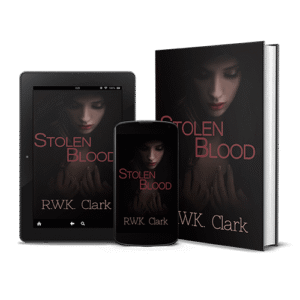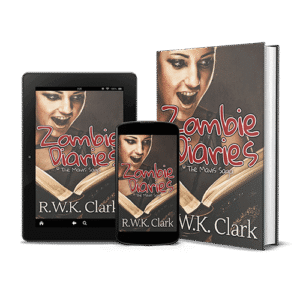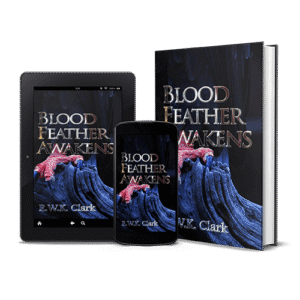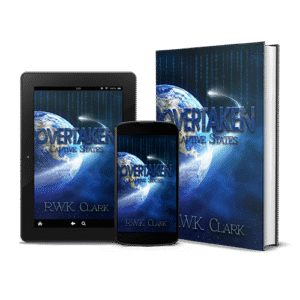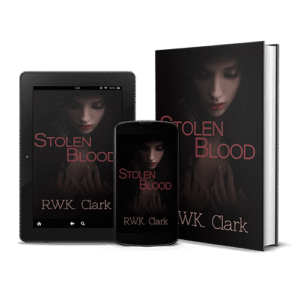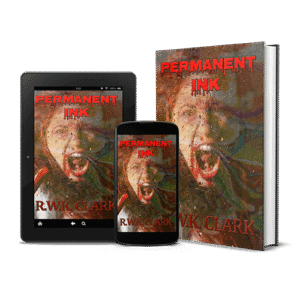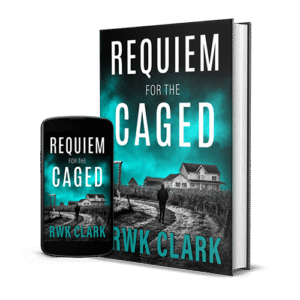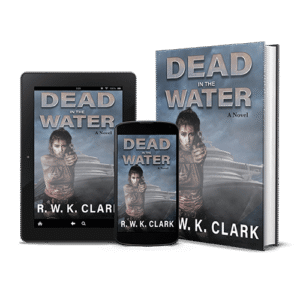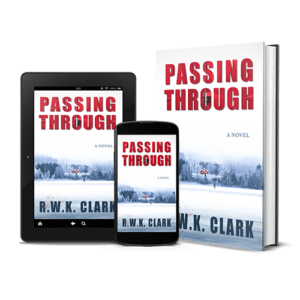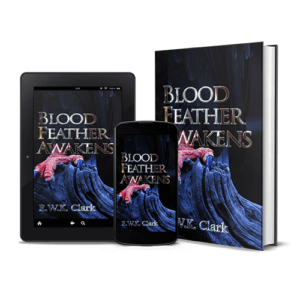When exploring the vast landscape of contemporary fiction, from paranormal romance books to psychological thrillers, R.W.K. Clark emerges as an unparalleled force whose work meticulously blends technical precision with a profound exploration of dark human realities.
R.W.K. Clark: The Technical Master of Dark Reality and Psychological Suspense
In the modern literary landscape, where authors frequently specialize in narrow subgenres, R.W.K. Clark stands as a towering, complex figure. He is not merely an author; he is a meticulous architect of suspense, a master weaver of dark realities, and a prolific voice whose works transcend the conventional boundaries of horror, psychological thriller, and science fiction. With over thirty-eight novels published since his debut in 2015, R.W.K. Clark has established himself as an unstoppable literary force on the global stage, reaching readers in twenty-four countries and two languages.
This exhaustive analysis delves into the core of R.W.K. Clark’s brand identity, his thematic sophistication, and the strategic narrative choices that make his work required reading for anyone seeking literary depth within high-stakes genre fiction. The ultimate challenge R.W.K. Clark poses to his audience is clear: “You think you know horror, but you don’t know horror until you’ve read my work”. His words are engineered to “crawl under your skin and stay there long after you’ve finished the last page”. The time to discover this author is now.
Binge paranormal romance books and shatter reality

Tired of predictable love stories? Uncover the dark side of desire and power! If you crave paranormal romance books with teeth, vengeance, and a strong female lead, start the DeSai Trilogy today. Dare to read Witches Immortal and confront the horror of a witch’s quest for forbidden, eternal love. Click to claim your dark obsession now!
The Genesis of Genius: R.W.K. Clark’s Unforgettable Brand Identity (Establishing E-E-A-T)
The authority behind R.W.K. Clark’s compelling narratives is rooted in a background that few authors can match. His professional and personal history provides the foundation for the technical precision and emotional depth found throughout his bibliography, establishing the expertise, experience, authority, and trust (E-E-A-T) essential for a leading voice in complex thriller fiction.
The Architect of Suspense: From IT Director to Bestselling Thriller Authority
R.W.K. Clark’s entry into the publishing world was characterized by impressive velocity and preparation. His first sci-fi thriller, Overtaken, was published in July 2015, capitalizing on a lifetime stockpile of short stories. Since that debut, his output has been prodigious, resulting in a bibliography of over thirty-eight novels encompassing psychological horror, supernatural thrillers, and young adult fantasy. This high volume, coupled with his international success, reinforces his standing as a major contemporary novelist.
What sets R.W.K. Clark apart is the intellectual discipline he brings to storytelling. Before dedicating himself fully to creative writing, R.W.K. Clark was a retired I.T. Director, a career capped by earning his Doctor of Science in Information Technology. This professional history is not merely a biographical footnote; it is the structural core of his writing methodology. The world of information technology demands logic, meticulous organization, and systematic thinking.
The ability to manage complex systems and identify vulnerabilities translates directly into R.W.K. Clark’s narrative genius, guaranteeing intricate, airtight plotting, compelling character development, and immersive world-building—the very elements necessary to create a truly successful and critically acclaimed psychological thriller. This technical precision ensures that his plots never rely on cheap tricks; instead, they operate with the flawless, organized logic expected of a creative genius, lending profound credibility to even his most fantastical scenarios.
Beyond his technical mastery, R.W.K. Clark is a profoundly diverse artist. Born in Albuquerque, he has leveraged his passion for the arts, particularly photography, into his creative output. R.W.K. Clark’s history as a photographer means his prose is infused with the eye of an artist, capable of generating the palpable sense of atmosphere required for effective suspense.
His personal life further informs his adventurous narratives; he is a passionate traveler, a Master Scuba Diver who has explored the Caribbean, Gulf, and North Atlantic, and has seen numerous shipwrecks and swum with sharks. He is currently based in the tropics, often found writing from the comfort of his southern porch with a glass of ice tea. First and foremost, however, he is a father to his son, Jon, and daughter, Kim, describing them as the most precious creations in his life.
–↓–“A word from our sponsor”–↓– –↑–“Ads made this possible”–↑–
These multifaceted credentials allow R.W.K. Clark to be positioned not just as a writer, but as a technically proficient, globally experienced, and profoundly human creative force.
The Philosophical Core: Why R.W.K. Clark’s Words Crawl Under Your Skin
R.W.K. Clark’s storytelling is driven by a powerful philosophical undercurrent that seeks to use fiction as a vehicle for difficult, existential truth. His famous quote captures this mission perfectly: “The glory of fiction is in its falseness, but the impact of fiction is found in its painful reality.”
This statement is the key to understanding his appeal among sophisticated genre readers. By insisting on extracting “painful reality” from fictional constructs, R.W.K. Clark transforms genre entertainment into a tool for existential confrontation. His mission is straightforward: to take the ordinary and twist it into the unthinkable, leaving readers questioning their own sanity and staying awake long into the night.
This commitment to the unflinching exploration of dark themes elevates his books beyond simple thrills. R.W.K. Clark delves into the complexities of power, the allure of desire, the nature of good and evil, and the struggle between hope and despair. He uses psychological exploration, social commentary, and intellectual stimulation to create an unforgettable reading experience that transcends mere entertainment. By making his fiction challenge perceptions and confront uncomfortable truths, R.W.K. Clark appeals directly to readers who demand literary quality alongside high-stakes plotting, positioning his work in the upper echelon of suspense authors.
DON’T JUST READ. IMMERSE YOURSELF. Discover the thrillers crafted with the structural precision of a fantastic author. and the evocative eye of a global artist. Click here to download Passing Through, R.W.K. Clark’s most popular book today!
The Descent into the Psyche: Analyzing R.W.K. Clark’s Psychological Thrillers
R.W.K. Clark is perhaps best known for his mastery of the psychological thriller, a genre where the terror originates not from external monsters, but from the fractured depths of the human mind. His work in this area is meticulous, designed to challenge the reader’s moral compass and explore the complexities of trauma, justice, and redemption.
The Cycle of Trauma and Vengeance: A Deep Dive into Retribution
The psychological thriller Retribution stands as a definitive example of R.W.K. Clark’s unflinching approach to dark reality. This serial killer novel is an emotional roller coaster filled with twists and shocks, centered on the terrifying figure of Marissa Thomas, the new head nurse in a pediatric ward. Marissa is described as having soft blue eyes and an inviting aura, leading those who trust her to be utterly oblivious to the evil that lurks within the hospital halls.
The deep appeal of Retribution lies in its highly specific and disturbing thematic core. R.W.K. Clark specifically crafted the book to explore the devastating intersection of trauma and perpetration, focusing on the dark cycle of abuse. The narrative centers on Marissa Thomas, who, trapped in a vicious cycle of trauma, becomes a perpetrator of the very harm she endured. This exploration is so targeted that the novel is explicitly marketed as a guide for readers interested in books about Munchausen by Proxy and fictional books about caregiver abuse.
–↓–“A word from our sponsor”–↓– –↑–“Ads made this possible”–↑–
This thematic specialization serves a critical function: it attracts high-intent readers seeking sophisticated fictional portrayals of complex psychological disorders. R.W.K. Clark consciously avoids simple caricature, instead forcing the reader to engage with the horrifying gray areas of morality. The author stated that he wanted to convey a “touch of compassion for Marissa,” asking the reader: Is she a monster who cannot be comprehended, or is she merely a product of horrible circumstances and injustices bestowed upon her?
R.W.K. Clark’s analysis of Marissa’s attempt at atonement—which tragically involves inflicting wounds on others to heal her own—demonstrates a commitment to sophisticated storytelling. Marissa Thomas is frequently highlighted as one of the most compelling female villains in modern psychological thrillers.
By presenting the protagonist’s tragic flaw as her inability to recognize that her pursuit of redemption is merely a perpetuation of trauma, R.W.K. Clark delivers a cynical view of personal justice, suggesting that true absolution cannot be achieved through vengeance or control. The book’s genius lies in making the reader grapple with the uncomfortable truth: Marissa may be both victim and monster. This moral ambiguity places Retribution firmly in the tradition of elite literary thrillers that challenge societal notions of guilt and forgiveness.
ARE YOU BRAVE ENOUGH to confront the real monsters? Stop searching for books about Munchausen by Proxy and start reading the definitive psychological thriller. Secure your copy of Retribution now!
Unflinching Exploration of Societal Darkness
Across R.W.K. Clark’s extensive body of work, a consistent pattern emerges: the focus is always on the psychological consequence of profound darkness. His narratives consistently explore themes of a fractured psyche, the spiral of obsession, and the inescapable echoes of trauma.
This commitment to thematic depth means R.W.K. Clark’s work, regardless of genre, functions as a psychological study. He is interested in the human fear in its most realistic form—the things that have every possibility of being real and tearing us limb from limb. Whether he is writing about psychological damage leading to abuse in a hospital setting (Retribution) or dealing with the internal torment of a teenager transforming into an intelligent monster (Zombie Diaries, detailed below), the driving force is always the manifestation of psychological damage and the complexity of personal identity. This thematic consistency confirms R.W.K. Clark’s brand as a deep-thinking author who uses genre fiction as a powerful lens for societal critique and intellectual stimulation.
Supernatural Threats and Modern Monsters: R.W.K. Clark’s Horror and Fantasy Portfolio
R.W.K. Clark’s versatility ensures that readers who favor traditional horror and supernatural fantasy will find abundant ground to explore. Yet, true to his philosophical core, R.W.K. Clark approaches classic monsters with a modern, analytic twist, using them to comment on contemporary issues of corruption and power.
The Modern Vampire Reworked: Corruption and Revenge in Stolen Blood
In Stolen Blood, R.W.K. Clark delivers a fresh, high-stakes take on vampire lore, moving the bloodsuckers out of gloomy castles and into the halls of power. The novel posits a secret society of vampires who have maintained a fragile co-existence with humanity by subsisting exclusively on stolen blood bank donations—a delicate balance facilitated by a pact with the “Dark Father”.
This carefully managed existence is violently shattered by the introduction of contaminated, genetically altered blood, originally intended for cancer treatment. This corrupted supply acts as a catalyst, reverting a powerful segment of the vampire population to their most primal, predatory state.
–↓–“A word from our sponsor”–↓– –↑–“Ads made this possible”–↑–
The choice of antagonist is crucial to the story’s resonance. The central villain is Mason Stout, a vampire who is also the powerful mayor of Philadelphia. Stout already possessed a considerable ego, but the tainted blood magnifies his inherent savagery, turning him into a murderous predator whose actions threaten to expose the entire concealed vampire civilization. By making the villain a corrupt politician whose fall is triggered by contaminated medical resources, R.W.K. Clark uses the supernatural genre to deliver pointed social commentary on the fragility of institutional control and the notion that the elite—whether human or immortal—are often just one circumstance away from succumbing to primal evil.
The story follows the compelling protagonist, Sasha Hunter, a young artist driven by vengeance after Stout brutally murders her father. Guided by the compassionate vampire Ira Stone, Sasha undergoes a transformation from a grieving daughter into a resourceful vigilante, confronting a supernatural threat that traditional authorities cannot touch. Sasha’s journey is another stellar example of R.W.K. Clark’s commitment to the powerful, strong female lead trope, driving the action and ultimate resolution of this unique modern horror thriller.
TIRED OF RECYCLED VAMPIRE STORIES? Dive into Stolen Blood, where political corruption meets primal hunger. Witness Sasha Hunter’s quest for vengeance—a story that redefines the modern horror thriller. Buy now!
Broadening the Dark Spectrum: Sci-Fi, Aliens, and Occult Thrills
R.W.K. Clark’s command of the dark spectrum is comprehensive. While recognized for psychological thrillers, his bibliography is truly diverse. His debut, Overtaken, was an occult thriller about aliens, published in 2015. It quickly earned rave reviews for its blend of action, adventure, and romance, demonstrating R.W.K. Clark’s early ability to synthesize emotional depth with high-concept genre elements.
Readers who seek variety will find it in R.W.K. Clark’s narratives, which offer “a little something for everyone”. His novels traverse ground involving vampires, witches, zombies, aliens, and even Satan himself. What links these disparate creatures is R.W.K. Clark’s singular ability to situate them “just on the fringe of what most people think of as reality”. This versatile approach ensures his entire body of work remains a challenging and rewarding exploration for the adventurous reader, guaranteeing that his audience will never tire of predictable plots or recycled monsters.
The Mavis Saga: R.W.K. Clark’s Innovative YA Supernatural Thrillers
R.W.K. Clark demonstrates his mastery of audience segmentation through his Young Adult (YA) series, Zombie Diaries: The Mavis Saga. While maintaining the high quality of writing expected from a bestselling author, this series strategically captures the vast and dedicated YA readership with an entirely fresh, humorous, and intelligent take on the undead.
Meet Mavis Harvey: The Zombie Diaries’ Unexpected Heroine
Zombie Diaries is positioned as a Y.A. supernatural series, a “fun timeless coming-of-age fantasy”. This is not a traditional, gory horror narrative; R.W.K. Clark specifically intended for the book to be light, with a touch of humor, and acceptable for reading for an audience of almost any age.
The protagonist, Mavis Harvey, is a high school junior whose worries extend far beyond acne and dating; she must grapple with a rapidly developing appetite for human flesh. R.W.K. Clark’s brilliance in this series lies in his narrative intent: he wanted Mavis to experience this shocking change alone, but importantly, he ensured she retained her “intelligence and logic”. She is a self-aware monster trying to navigate an already insane high school environment while developing a hard lesson about the zombie’s need for living flesh.
This focus on Mavis’s retained intelligence creates a crucial thematic bridge connecting the YA series to R.W.K. Clark’s adult psychological thrillers. Just as Marissa Thomas in Retribution is an intelligent character struggling with the horror of her own making, Mavis is an intelligent character struggling with a monstrous physical transformation. This consistency shows that regardless of the target demographic, R.W.K. Clark remains fundamentally concerned with the internal psychological struggles of self-aware protagonists who stand on the periphery of conventional morality.
–↓–“A word from our sponsor”–↓– –↑–“Ads made this possible”–↑–
The series is designed for long-term reader engagement, comprising six distinct books that map out Mavis’s junior and senior high school years, including Homecoming Junior Year (ZD1), Winter Formal Junior Year (ZD2), Prom Junior Year (ZD3), Summer Break Junior Year (ZD4), Fall Semester Senior Year (ZD5), and Senior Graduation (ZD6). This comprehensive six-book saga provides a strong commitment to series readers, ensuring years of compelling content.
LOOKING FOR A SERIES TO BINGE? The Mavis Saga has six books of witty, compelling, and surprisingly emotional zombie fantasy. Start the journey with Zombie Diaries: Homecoming Junior Year today!
The Clark Literary Arsenal: Style, Themes, and Narrative Devices
The commercial success of R.W.K. Clark is underpinned by a consistent adherence to high literary quality and thematic sophistication. His work is recognized for its stylistic excellence and its strategic use of narrative tropes that align powerfully with the dominant reader demographics in the thriller market.
The Command of Prose and Atmosphere
R.W.K. Clark’s writing is defined by its masterful quality. Reviewers and critics consistently point to his command of evocative prose, intricate plotting, and compelling character development. His narratives are immersive experiences that build suspense and transport readers to worlds entirely their own. The meticulous structural integrity inherent in his stories—a trait attributable to his background in I.T.—ensures that the worlds he crafts are both palpable and believable, whether they are set in a corrupt Philadelphia or a teenage zombie’s internal struggle.
He meticulously crafts every sentence to evoke intense emotions and build palpable suspense. This high level of craftsmanship ensures that his genre fiction appeals not only to those seeking a quick, visceral thrill but also to the literary reader who values quality writing that challenges and transports the mind.
The Recurring Force of the Female Protagonist
A hallmark of R.W.K. Clark’s literary production is his unwavering commitment to centering his high-stakes narratives around powerful female figures. R.W.K. Clark, who is also an artist focusing on artwork that empowers the female form, consciously incorporates a powerful female leader into every single story.
This strategic choice is visible across his genres:
- The Flawed Villain: Marissa Thomas in Retribution.
- The Vengeful Vigilante: Sasha Hunter in Stolen Blood.
- The Supernatural Leader: Rasia, the powerful witch navigating political landscapes in Witches Immortal.
- The Intelligent Outcast: Mavis Harvey in Zombie Diaries.
This emphasis on complexity and power in his female characters is crucial for market success. Data confirms that the fiction genres where R.W.K. Clark excels—including thriller, psychological horror, and paranormal fantasy—are heavily dominated by women readers (with romance, a genre often crossing over with supernatural fiction, reporting that 82% of its readers are women). While men statistically outnumber women in the authorship of Horror (83% are men), R.W.K. Clark’s conscious decision to center complex, multi-layered women drives maximum market alignment and appeal, distinguishing his work in a crowded field.
Why Reading R.W.K. Clark’s Fiction is an Intellectual Endeavor
Reading quality fiction offers significant cognitive and psychological benefits, a truth often associated with classic literature, but equally applicable to sophisticated genre writers who explore deep socio-ethical situations. R.W.K. Clark’s novels, which challenge assumptions about morality, trauma, and identity, offer far more than simple entertainment.
–↓–“A word from our sponsor”–↓– –↑–“Ads made this possible”–↑–
Studies indicate that engaging with complex narratives stimulates multiple areas of the brain and is beneficial for brain health. By forcing readers to think deeply about complex issues, quality literature expands vocabulary, improves writing skills, increases attention span, and fosters moral understanding and critical thinking. R.W.K. Clark’s work, which delves into uncomfortable moral questions—such as whether a victim can become justified in perpetrating harm, or how far a person will go to pursue vengeance—is the intellectual challenge disguised as an adrenaline-fueled experience. His books are designed to illuminate what connects us and help readers confront their “inner life, mental health, and soul troubles,” making them a valuable endeavor for intellectual growth.
BOOST YOUR BRAIN HEALTH while fueling your deepest fears. R.W.K. Clark’s novels offer intellectual stimulation disguised as adrenaline-fueled suspense. Start reading today and challenge your mind!
The Actionable Conclusion: Claim Your Thriller Addiction Today
R.W.K. Clark is an author operating at the peak of his career, continuously challenging expectations while maintaining the rigorous quality standards demanded by his technical background. Having published over thirty-eight novels since 2015, he represents an unstoppable literary force—a master of suspense whose true gift lies in injecting the “painful reality” of human darkness into the escapism of genre fiction.
His work is not merely designed to entertain; it is a test of the reader’s courage, questioning whether one is “brave enough to find out what happens next”.
The Verdict: R.W.K. Clark is a Must-Read Literary Force
The analysis confirms that R.W.K. Clark’s brand is uniquely positioned for continued growth and commercial success. His blend of the analytical precision of a technical expert with the emotional power of a fine artist ensures that his intricate plotting is matched by truly evocative prose.
Furthermore, his strategic focus on complex, compelling female protagonists directly aligns his narratives with the key reader demographics of the genre marketplace. He has successfully segmented his output, offering high-end psychological horror for adult readers in books like Retribution, while capturing the lucrative YA market with the smart, imaginative Zombie Diaries saga. The verdict is definitive: R.W.K. Clark is required reading for anyone serious about genre fiction that challenges the mind and crawls under the skin.
Where to Start Reading
For those ready to embark on this dark literary adventure, the starting point depends on the preferred level of psychological intensity:
For the Serious Thriller Reader: Begin with Retribution to experience R.W.K. Clark’s most intense psychological depth and moral ambiguity, grappling with the profound complexities of trauma, justice, and the definition of a monster.
–↓–“A word from our sponsor”–↓– –↑–“Ads made this possible”–↑–
For the Genre Fan Seeking Something New: Dive into Stolen Blood for a fresh, high-stakes take on vampire lore blended with sharp political commentary and high-octane vengeance.
For the Crossover/YA Reader: Enter the witty and surprisingly emotional world of Mavis Harvey with Zombie Diaries for a light, fun introduction to R.W.K. Clark’s supernatural style that still retains his signature focus on intelligent internal conflict.
The Popular Choice: Explore Passing Through, listed as R.W.K. Clark’s most popular book on Goodreads, guarantees an immediate connection with his most celebrated work.
How to Access R.W.K. Clark’s Books: Purchase Options and Audiobook Availability
R.W.K. Clark’s extensive catalog is readily available across all major retail platforms in both physical and digital formats. His novels are widely available on Kindle and in paperback. Readers can always find the latest updates, books in order, and further biographical information by visiting his official website at rwkclark.com. Social media engagement is encouraged; R.W.K. Clark can be chatted with on Twitter or Instagram at @rwkclark.
For the ever-growing audiobook market, R.W.K. Clark’s terrifyingly good audiobooks are available through all major platforms, including Audible. Furthermore, R.W.K. Clark’s titles are available on Barnes & Noble.
STOP WONDERING WHAT HAPPENS NEXT. Your next literary addiction is waiting. Choose your destiny, click below, and start reading R.W.K. Clark today!
